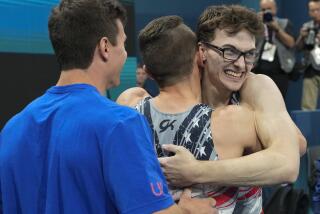Riders Train to Perfect the Equestrian Art of Dressage : Sports: A world-class trainer helps local Olympic hopefuls combine balance, precision and grace.
- Share via
Metternich, a 14-year-old stallion, extended his front legs powerfully and gracefully in a slow, high-stepping trot before a crowd of 50 dressage enthusiasts who gathered Monday near Thousand Oaks for a display of the centuries-old equestrian sport.
His diminutive rider, Betsy Steiner, almost imperceptibly used her 105 pounds to get the 1,400-pound thoroughbred to seemingly float the entire 60 meters of the arena at Hidden Valley’s Sandstone Ranch.
Steiner was one of nine top West Coast dressage riders who took to the arena with their mounts, invoking analogies to gymnastics, figure skating and ballet.
“They’re like ballerinas--very big ballerinas,” said Beth Clarke, dressage director of the U.S. Equestrian Team, a New Jersey-based organization that sponsors competitions where Olympic hopefuls garner needed points.
And some of the nation’s biggest and best equine ballerinas and their riders are gathered this week in Thousand Oaks, as one of the world’s best dressage trainers puts on a three-day clinic scheduled to conclude today.
Klaus Balkenhol, an Olympic bronze medalist for Germany in 1992, led several of the West Coast’s top riders through a series of workouts despite the constant drizzle. Included in the rain-soaked group were Thousand Oaks residents Steiner, 44, and Dennis Callin, 37.
Steam rose off of Callin’s horse as the 1996 Olympic hopeful sat ramrod straight in a polished black saddle and received instructions from the German master.
“Nein, nein, “ Balkenhol barked at Callin. “Shorten up the reins and keep your hands down.”
Callin nodded, wiped the rain from his face with a gloved hand, gave a subtle command and his mare, Gladly, broke into a canter.
It was yet another step in horse and rider’s long march to the games in Atlanta.
“There is a lot of hard work and quite a bit of luck needed to get to the Olympics,” said Steiner, another hopeful.
Time and money also make a difference.
It takes about five years to get a dressage horse--the best of which cost $500,000--into Olympic-caliber condition. In the meantime, the horses have to be housed, fed and cared for--not to mention shipped across the country and around the world for competitions.
“You have to be patient,” Steiner said. And for 27 years, Steiner has been patiently plying her trade, working toward her goal of competing in the Olympics. Steiner came close to qualifying for the 1988 Olympics in Seoul before a horse kicked her and broke her leg.
Steiner, a trainer who lives at Sandstone, said she hopes her patience will pay off with an Olympic berth. She believes she has the right animal.
“I have a great horse,” she said. “Not a good horse, a great one.”
Under the watchful gaze of Balkenhol, Steiner and Metternich went through a 45-minute workout.
She said the workout was a good primer for an upcoming competition in which she needs to do well to continue on her Olympic quest.
“The horse is a huge puzzle that you continually have to figure out,” she said. “Klaus points out that each horse is an individual and he helps bring out their personalities.”
Balkenhol’s appearance in Thousand Oaks this week was a testament to the region’s increasing influence in the understated sport in which horse and rider work through set tests of intricate moves, riders and trainers said.
“This has been an East Coast sport for a while,” Clarke said. “But some of the best riders in the world live here.”
This has been a fortunate change of events for area fans of a sport long dominated by Europeans.
“The area is incredible,” said Victoria Netanel, an amateur rider who boards her horse at the same Hidden Valley barn as Callin. “We are lucky to be around so many top riders. It makes everybody work harder.”
More to Read
Go beyond the scoreboard
Get the latest on L.A.'s teams in the daily Sports Report newsletter.
You may occasionally receive promotional content from the Los Angeles Times.







